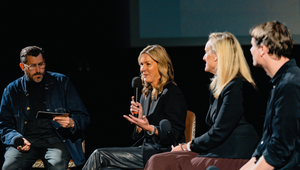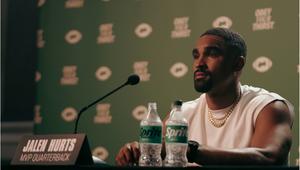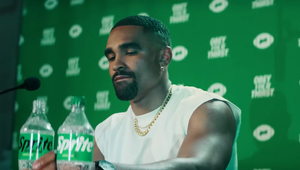
Ad Astra: Rob Reilly, a Charming Provocateur

“Look like a champion, play like a champion.”
Over the course of our conversations, I’m treated to two strong hat looks from Rob Reilly, WPP’s global chief creative officer. A Madchester-esque bucket hat and a flamboyant camo number from the FlameKeepers Hat Club. Those who’ve known Rob a long time won’t be surprised. He is, in the words of ZZ Top, a sharp dressed man.
But Rob’s sartorial pizazz isn’t just about having fun with the dressing up box - although he relishes that creatives have a lot more licence to play with their style than other professions. No, for Rob, it’s a brand, a badge and a message - a distillation of his creative principles and a very personal part of his own creative process.
The seeds of his sense of style lie with his grandparents. His grandfather, an artist who worked for advertising agencies, would wear louche oversized shirts, carefully folded at the sleeves, a look Rob’s partial to to this day. He recalls a creative director from his past who would wear ‘these super fucking cool blue glasses’ - a man who just radiated style and creativity. Now, he says, he likes people who have put effort into looking good and interesting.
“I do think there’s a reason why creative people dress interesting. One it makes them feel more creative when they’re dressed creative, but you’re also badging to people. Just like finance people dress in $2000 suits because they want to badge that they are people who understand money,” he says. “I think if you’re creative, you have the luxury of dressing somewhat eccentric. I feel we have the leeway,” he says, revelling in the ability to surprise.
Ultimately, that attention to style is a reflection that Rob really cares. He cares about people who make an effort. He cares about the details. He cares about the intertwining of form and function (which applies as much to advertising as it does to the Arne Jacobsen Swan chair; mid century seating is another obsession). He cares about winning - and looking like a winner.
In his younger days, he recalls, he would arrive early to polish the office’s brass doorknobs to a high shine before clients came to call. These days he sees an agency’s presentation, down to food in the meeting room, as a signal to clients. And he cannot abide being late. “Stains on the carpet? Get them out. If you can’t take care of yourself or take care of your office, how can you take care of my brand?”
Rob Reilly loves to win. Scratch that, he lives to win. And he isn’t afraid of the sheer graft it takes to win. When he was global creative chairman of McCann Worldgroup, “Out-think, out-work, out-care” became a rallying cry around the network, but it’s an ethos that goes much further back than that. Further back, even, than his time at Crispin Porter + Bogusky when the agency was renowned for its graft and craft as it put out campaign after campaign of fastidiously-honed irreverence. That single-mindedness and grit was fostered through a love of sports through childhood - West Ham fan Rob played competitive soccer right up into his college days. Even today, he’s not averse to a bit of one-on-one on the basketball court with WPP’s global head of production.
“You know, I don’t think I’m the smartest, I don’t think I’m the best writer or the best of anything, but I definitely will outwork you and be tenacious about it. And you need people to help you,” he says. “I have a lot of time for people, as much as I can, certainly for younger people that are trying to break into the business because it took me a long time.”
Whatever way you cut it, from the work to the details of agency presentation to making space for those on the outside desperate to get in, ‘care’ is a verb and noun that crops up a lot when talking to Rob. He recalls getting so absorbed by the minutiae of a potential client’s possible positioning on a pharmacy shopping cart during a pitch meeting that a young account manager commented, “wow, you really make it seem like you care about this stuff.” But that’s the thing. It doesn’t seem like he cares… he just… cares. “That’s the whole trick of it. You can’t fake it. You really have to care about this product and how it can be meaningful in someone’s life.”
What he doesn’t have time for is the martyred ageism of leaders who bemoan quiet-quitting, checked-out gen z. That sense of care is palpable among his youngest creatives.
“It’s a misconception that young people don’t care. I think that’s really insulting. There are some young people that don’t care - and there are middle aged and old people that don’t care. I think it’s more of a personality type than it is an age thing.”
As a leader of the world’s biggest holding company, Rob’s had to navigate leading a team that contains people who care with the intensity that he does and the people who don’t so much in the same way. “There are people who care and people who don’t care as much - and in a big company you have to be OK with that,” he says. “I think the world sorts itself out, if you put the work in, and you’re talented, nice and positive, you usually rise up.”
Perhaps the most instructive example of Rob’s ‘out-work’ mentality is his entry into the industry. Keen to get his foot in the door, he worked as a secretary at Taylor, Gordon & Partners, a small agency that would rent office space from bigger agencies that were going out of business. It was a crucible experience.
“I might be at WPP, the biggest marketing company in the world, but I have a small-agency mentality. Part of that is waking up with a bullseye on your back and having that sense of urgency. It started from seeing agencies close right before your eyes. [Knowing] what that felt like, seeing people cry as the marshalls came in locking the doors, it just stuck with me. I was like, ‘man, I am never going to be in that situation. I’m going to always hustle my way into things and never take anything for granted.’”
Hustle he did. Getting started as a creative took relentless grind. After tirelessly knocking on doors, Rob was getting nowhere. Things were getting so desperate, his Italian American New Jersey mother took it upon herself to ask around her ladies’ bowling league. Proof, were it even needed, that mother always knows best, she came up trumps as a fellow bowler offered to connect Rob with McCann’s Bruce Nelson, then in a global creative role. Bruce promptly told Rob he didn’t like his look, but sensing some potential, told him to keep trying. It took more than a year of work, rejection, and more work for Rob to get his first creative job, writing convenience store stickers and radio ads for Coca-Cola at McCann.
“That’s one of the reasons I went back to McCann - they were the only agency that believed in me. But it took me a long time to break in. I needed luck and persistence and someone in a high position to give me a shot - but not an easy one,” he says.
This whole anecdote isn’t just an illustration of the hard work and tenacity that has fuelled Rob’s creative career, it also speaks to another theme that’s core to Rob’s creative philosophy: feedback.
He believes that it’s up to leaders at brands and agencies to create an environment where feedback isn’t cruel and where creatives have the freedom to swing big and miss spectacularly. “Fear is debilitating. Fear for your job, fear of being fired from the client, fear of people thinking you’re a nutjob. I think we need more people that are a bit off-kilter, I think we need ideas that are off-kilter. I think we need to create an environment where ideas can be shared, where people are fearless, without any repercussions.”
But that’s only half of it - feedback and outright rejection of ideas is simply a reality of being a creative. What’s key is what they do with that feedback. “I also think agencies and creative people have to have a thicker skin and have to be willing to be a fountain of ideas. You need to show 100 great ideas to sell one. That’s the new ratio,” he says. “The skill isn’t coming up with an idea that is pure.
“The real skill in a creative person is, can you take the feedback and turn it into something? You can either take that feedback and turn it into gold or you can take that feedback and you can sulk in the corner.”
And if you’re giving feedback, Rob says, at least be charming about it. He calls this mode ‘the charming provocateur’. It’s a brand that can really pull off a hat.
That lightness of touch hasn’t always come easy. Rob reflects on the culture of being ‘merciless’ at Crispin, driven as they were, and the ‘collateral damage’ that came from that. And so Rob engaged in something career-changing: coaching. That experience transformed Rob’s career.
“I wouldn’t have this job if I didn’t do coaching. I think that’s another thing we don’t provide enough for creative people. It’s expensive, but it’s the reason I have this job. I think we put creative people in positions they are not yet trained for and don’t do anything to really help them.”
His own experience of coaching has led Rob to focus some of that intense, caring energy and channel it into mentoring and supporting creatives. He is keenly aware that, unlike other industry specialists like producers or accounts people, who tend to rise up the ranks in a relatively ordered and sequential manner, learning as they go, an award-winning creative can quickly be catapulted to a leadership position with less training. He mentors many creatives at WPP, and frequently gets requests from people outside of the holding company.
Before feedback, though, is the brief. Pre-feedback, if you will. Writing it is Rob’s favourite part of any creative project. “When I sit with clients and talk about the brief, I always remind them this brief is not for you or me. It’s for that junior team that has to show work to Liz Taylor [Ogilvy’s global CCO] at 9am and it’s midnight and they have nothing. That brief is either their best friend or their worst nightmare,” he says. “Make it their best friend. Make it simple. Make it pointed. Have a question that we’re trying to answer. Have some tension. What’s the headline going to be… Put some free ideas in there.”
The best clients, of course, cultivate an understanding of what creatives need - just as, hopefully, the best creatives cultivate a mutual empathy. Kathleen Hall, Microsoft’s chief brand officer, is quite simply, in Rob’s words, ‘legit’. “With our relationship that we built over ten-plus years of trust, she knew I was not going to let her down. I knew she would go into battle fighting for the right ideas, fighting for the money to make them, fighting for the places to make them shine.”
Another client relationship that Rob highlights for its mutual trust and the fertile environment it fosters for big, wild ideas is that between VMLY&R and Wendy’s. In an industry bustling with awards, it’s the One Show’s Penta Pencil, awarded for stellar work created consistently over five years.
For clients or creatives keen to foster such relationships, Rob has a few words of advice. Clients, he urges, will get more from their creatives when the feedback is not didactic, with a checklist of what’s wrong and how to fix it. Instead, he says, explain your philosophical issues so that creatives can work their magic and come up with a solution. He reflects that the blockbuster ‘Fearless Girl’ statue that picked up every award going in 2017 back when Rob was at McCann was the product of client feedback.
As for creatives, some understanding of the pressures and obstacles clients face would go a long way. “I think creative people are really simple. If you care deeply about creativity, then we trust that you’re going to try to do the right thing. I think creative people also have to have a lot of empathy for clients, that they want to do the bold thing - but it’s not always that easy,” he says. “I think we could all benefit from sharing some empathy.”
That empathy and humanity is set to become even more key as artificial intelligence takes hold and shapes the industry. As far as Rob sees it, it’s a tool that will unleash creatives from the trap of ever-tightening deadlines and shrinking space for true client-boosting experimentation.
“I think it will be a game-changer for creative people,” says Rob. He’s most excited about the time saving element of it. “Because what we’ve sucked out of the business is all the time and money for experimentation and failure. AI, in my opinion, in the ideation stages, is going to bring back the ability to explore, experiment and to fail at a very low cost and a low cost when it comes to time.”
Resistance is likely to be futile. WPP has embraced AI, with notable deals and collaborations with the likes of Nvidia and Microsoft. Rob, who insatiably follows technological developments on social media platforms like TikTok, thinks that creatives should seriously consider similarly getting up to speed with the new creative toolkit.
“The computer was brought into our lives and art directors who were like, ‘I’m going to keep drawing by hand, forget the computer’, well, those art directors don’t exist any more. This is just another tool for creative people, and the ones that embrace it, use it and master it, I think, are going to be the ones that end up going to the top fastest.”
Whatever impact AI has, world changing or merely world nudging, the value of creativity is enduring. “The only metric that matters is amazing ideas, beautifully crafted, that are wildly effective. That’s the whole business in my opinion, or the future of it. It’s getting harder and harder to break through, so earned media has to be the thing you think about in the future. How do I make ideas that people love and share and spread, and that the press writes about? It’s too competitive, there’s not enough money, we don’t have any choice. It sounds daunting but at the same time, it puts a premium on creativity.”
Thankfully, that’s not something he’s short of as the creative champion of all of WPP’s creative, media, data, tech and production brands. There are plenty of campaigns that are hitting that sweet spot of creativity, effectiveness, and collaboration.
Corona ‘Extra Lime’, for example, is the transformative, Titanium Grand Prix-winning project from DAVID Bogota that has brought brand love and business growth to China. It’s a campaign that sought to bring the iconic Corona and lime combo to the world’s biggest beer-drinking market by supporting local farmers to create a brand new revenue stream. “That’s probably my favourite because of all it stands for: it’s in China and it’s been put on a pedestal, to a degree, by the Chinese government.”
In India, the ongoing collaboration between Ogilvy, Wavemaker and confectionary giant Cadbury has been realising that dream of bringing together creativity and AI to find solutions that wouldn’t otherwise be possible. From ‘Shah Rukh Khan My Ad’, which used AI to generate 130,000 bespoke ads starring the Bollywood megastar for small shops to a newer campaign that allows friends to create personalised birthday songs, the two WPP agencies have been realising that adland dream of creativity, tech and data. For Rob, the real story of that work is the way the two agencies and the Cadbury client came together.
“I think the future of creativity is collaboration: collaboration with creatives, with technology, collaboration with media. I feel like it’s got to get way tighter, way closer, have media infused in the creative process. Lastly, I think it’s going to be collaboration with Hollywood to Bollywood and everything in between.”
For work that’s world-changing, Rob looks to ‘Access Codes’ from Grey and Hill+Knowlton Strategies. It uses barcodes as portals that allow users with disabilities to listen to audio descriptions of vital product information. It exemplifies the burgeoning accessibility practices that are growing around the WPP network. “We do have a responsibility, but I don’t think it’s making money or doing the right thing. We have to really figure out how these work together. It’s not one or the other.”
All of these ideas have turned into big wins for WPP and great vindication of that sportsman’s mentality, of work, passion and teamwork - not to mention tenacity. Some, like ‘Access Codes’, have been years in the making.
And that sportsman’s mentality is everything. It doesn’t mean winning at all costs, or without humanity. It means winning the right way. It means working as a team, protecting people’s personal lives and collaborating positively and helping your folk grow in the process. But it does mean winning.
“In the end, winning is the culture you’re trying to cultivate. Winning fixes a lot of things. Yes you will want to be supportive and have a place where people can bring their dogs… but I promise you it doesn’t matter how cool your office is, how many snacks there are in the breakroom, it doesn’t matter how many dogs are allowed to bark. When you’re winning, there’s nothing that replaces that adrenaline rush you get from putting so much work into it and the end result being a win.”















